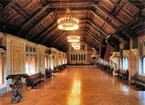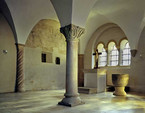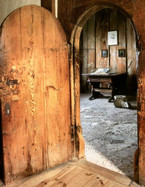Martin Luther at Wartburg Castle
Scarcely any other name and place are so closely associated in the popular mind as Luther and Wartburg Castle. In fact, the religious reformer only spent a relatively short time there, from 4 May 1521 until 1 March 1522, but it was during this period that he translated the Bible into German, an achievement that made Wartburg Castle famous as one of the locations of the Reformation. Strictly speaking, he "only" translated the New Testament his modest cell in the bailiff's lodge in the winter of 1521-1522. The complete Lutheran Bible would take him another twelve years. Luther's translation of the Gospels also started the standardisation of the German language.
How did the church reformer come to be at Wartburg Castle? After his intrepid appearance at the Diet of Worms, Luther was in great danger and clearly had to be taken to a place of safety. A fake kidnapping was staged, which Luther reluctantly took part in - understandably in view of his situation. During the evening of 4 May he was taken into hiding at Wartburg Castle where he transformed himself into Squire George. He let his beard and hair grow long in the style of a knight, wore smart clothes, carried a sword and was soon unrecognisable.
With time on his hands in the peace and quiet of Wartburg Castle, Luther experienced one of his most productive periods. It was mainly out of boredom that he picked up his quill pen and translated the New Testament - in just ten weeks. Unlike his predecessors, Luther used the original Greek text. His many letters indicate how isolated he felt in exile. He ended his letters with greetings from "Patmos", from his "hermitage" or from the "realm of the birds", although it is not clear whether he meant the castle's snowy white doves, the omnipresent birdsong in the woods or Hans von Berlepsch, the keeper of the castle, whose family coat of arms depicts five parakeets. The castle keeper is said to have looked after his ward well, but Luther enjoyed neither the hearty food eaten by the nobility, which he found indigestible, nor the hunt he was once taken on.
Although Martin Luther wrote about a variety of things, including strange noises in the old walls that made him believe the devil was there, he did not mention a word about the story that he had hurled an ink pot at his tormentor. He may well have fought evil with pen and ink, but the vivid story of Luther's battle with his ungodly adversary has only been a firm fixture in the history of Wartburg Castle since the 17th century. Generations of people have scratched their name and the date in the wooden boards of the bare room, which has been referred to as "Dr Martin's room" in castle records since 1574. Even today, people ask about the ink stain that was dreamt up at some point in history and was renewed time and again until the end of the 19th century.


